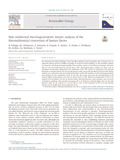JavaScript is disabled for your browser. Some features of this site may not work without it.
| dc.contributor.author | Fidalgo, Beatriz | |
| dc.contributor.author | Chilmeran, M. | |
| dc.contributor.author | Somorin, Tosin Onabanjo | |
| dc.contributor.author | Sowale, Ayodeji | |
| dc.contributor.author | Kolios, Athanasios | |
| dc.contributor.author | Parker, Alison | |
| dc.contributor.author | Williams, Leon | |
| dc.contributor.author | Collins, Matt | |
| dc.contributor.author | McAdam, Ewan J. | |
| dc.contributor.author | Tyrrel, Sean F. | |
| dc.date.accessioned | 2018-09-10T15:27:05Z | |
| dc.date.available | 2018-09-10T15:27:05Z | |
| dc.date.issued | 2018-08-29 | |
| dc.identifier.citation | Beatriz Fidalgo, M. Chilmeran, Tosin Somorin, et al., Non-isothermal thermogravimetric kinetic analysis of the thermochemical conversion of human faeces. Renewable Energy, Volume 132, March 2019, Pages 1177-1184 | en_UK |
| dc.identifier.issn | 0960-1481 | |
| dc.identifier.uri | https://doi.org/10.1016/j.renene.2018.08.090 | |
| dc.identifier.uri | http://dspace.lib.cranfield.ac.uk/handle/1826/13472 | |
| dc.description.abstract | The “Reinvent the Toilet Challenge” set by the Bill & Melinda Gates Foundation aims to bring access to adequate sanitary systems to billions of people. In response to this challenge, on-site sanitation systems are proposed and being developed globally. These systems require in-situ thermal treatment, processes that are not well understood for human faeces (HF). Thermogravimetric analysis has been used to investigate the pyrolysis, gasification and combustion of HF. The results are compared to the thermal behaviour of simulant faeces (SF) and woody biomass (WB), along with the blends of HF and WB. Kinetic analysis was conducted using non-isothermal kinetics model-free methods, and the thermogravimetric data obtained for the combustion of HF, SS and WB. The results show that the devolatilisation of HF requires higher temperatures and rates are slower those of WB. Minimum temperatures of 475 K are required for fuel ignition. HF and SF showed similar thermal behaviour under pyrolysis, but not under combustion conditions. The activation energy for HF is 157.4 kJ/mol, relatively higher than SS and WB. Reaction order for HF is lower (n = 0.4) to WB (n = 0.6). In-situ treatment of HF in on-site sanitary systems can be designed for slow progressive burn. | en_UK |
| dc.language.iso | en | en_UK |
| dc.publisher | Elsevier | en_UK |
| dc.rights | Attribution 4.0 International | * |
| dc.rights.uri | http://creativecommons.org/licenses/by/4.0/ | * |
| dc.subject | Pyrolysis | en_UK |
| dc.subject | Combustion | en_UK |
| dc.subject | Thermogravimetric analysis | en_UK |
| dc.subject | Kinetics | en_UK |
| dc.subject | Human faeces | en_UK |
| dc.subject | Nano membrane toilet | en_UK |
| dc.title | Non-isothermal thermogravimetric kinetic analysis of the thermochemical conversion of human faeces | en_UK |
| dc.type | Article | en_UK |
Files in this item
The following license files are associated with this item:
This item appears in the following Collection(s)
-
Staff publications (SWEE) [2815]

